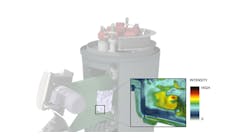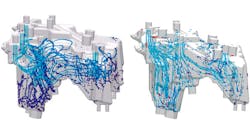Metalcasters that subscribe to simulation software don’t have to wait for a major events to feel the thrill of a new technical development or process breakthrough: over the past decade or so, the expanding scope of process analysis and simulation has meant that every production cycle offers the potential for new discovery. Still, the arrival of MAGMA5 Release 5.3 last month at GIFA 2015 revealed more generally how simulation software has become not just the means of discovery but the venue in which metalcasting’s most significant industrial development is taking place.
Metalcasters use MAGMA5 software to simulate mold filling, solidification and cooling, in advance of the start of production. More critically, the software improves product design by helping to identify residual stresses and distortion, microstructure formation and property distributions in castings.
The new release raises the emphasis on product and process design by making it possible for foundries to conduct “virtual experimentation and automatic optimization on-screen.”
Process conditions and optimized solutions for casting layouts and part production can be determined before the first casting is produced — e.g., determining runner dimensions, locating gates, placing and sizing feeders and chills — which raises the software’s value as a platform for foundries to identify their potential risks and opportunities.
MAGMA5 5.3 introduces parametric design functions, meaning it’s possible for users to evaluate various casting geometries, and new statistical tools that expand the users’ ability to conduct experimental analysis for casting process optimization. A new Assessment Perspective speeds and simplifies quantitative comparison of simulation results. “Virtual experimentation and optimization are thus fully integrated into MAGMA5 for the first time,” according to the software developer.
Among the new process applications of in MAGMA5 5.3 are several options for improving coremaking. The MAGMA C+M module simulates core shooting, gassing and hardening for organic and inorganic cores, and it introduces additional criteria for optimizing corebox layouts and predicting core box wear. In addition, air and sand flows in the coremaking process can be visualized more effectively with tracer particles.
Another Magma revelation at GIFA was the software’s increasing value as a tool for material and metallurgical research, e.g., for new product development. It introduced capabilities for quantitative prediction of as-cast and heat-treated properties in aluminum, cast iron, and steel castings. The MAGMAnonferrous and MAGMAiron modules can be used to calculate microstructures and mechanical properties by considering metallurgy, inoculation and alloy composition. Another new development makes it possible to evaluate heat treatment for austempered ductile iron.
MAGMAsteel predicts filling-related sand and reoxidation inclusions, and calculates both macrosegregation and microstructures resulting from heat treatment in steel castings.
A new radiation model tracks heat transfer for investment casting processes, taking into account different radiation conditions and shadowing effects. The MAGMAstress module identifies thermally induced stresses in castings and permanent molds to predict crack problems and distortion in all process steps, including heat treatment and machining.
Simulated distortion results can be evaluated similar to using a CMM, and can be directly compared with real measurements. Creep effects in the cast material during cooling and heat treatment are considered. MAGMAdielife allows evaluating the die life of permanent molds.
Looking forward, Magma’s GIFA presentation made clear that simulation is also a venue for communication, and for education. It demonstrated how the software is a comprehensive and effective tool for training and testing foundry workers and casting designers, as well as for demonstrating capabilities and options for casting consumers. And, Magma introduced its plan to promote a series of seminars to show metalcasting experts how to work with simulation results to maximize the value of process optimization. The technology may be simulation, but the effects are all very tangible.









